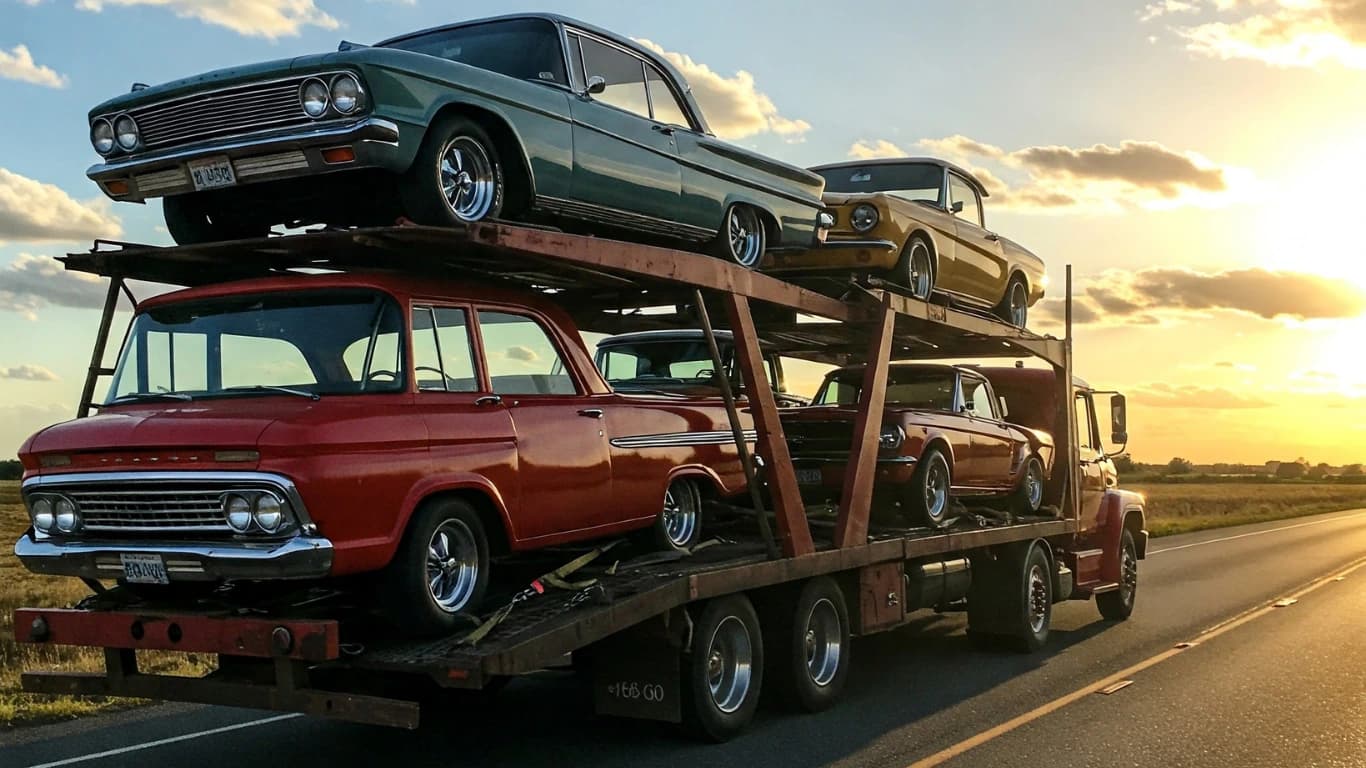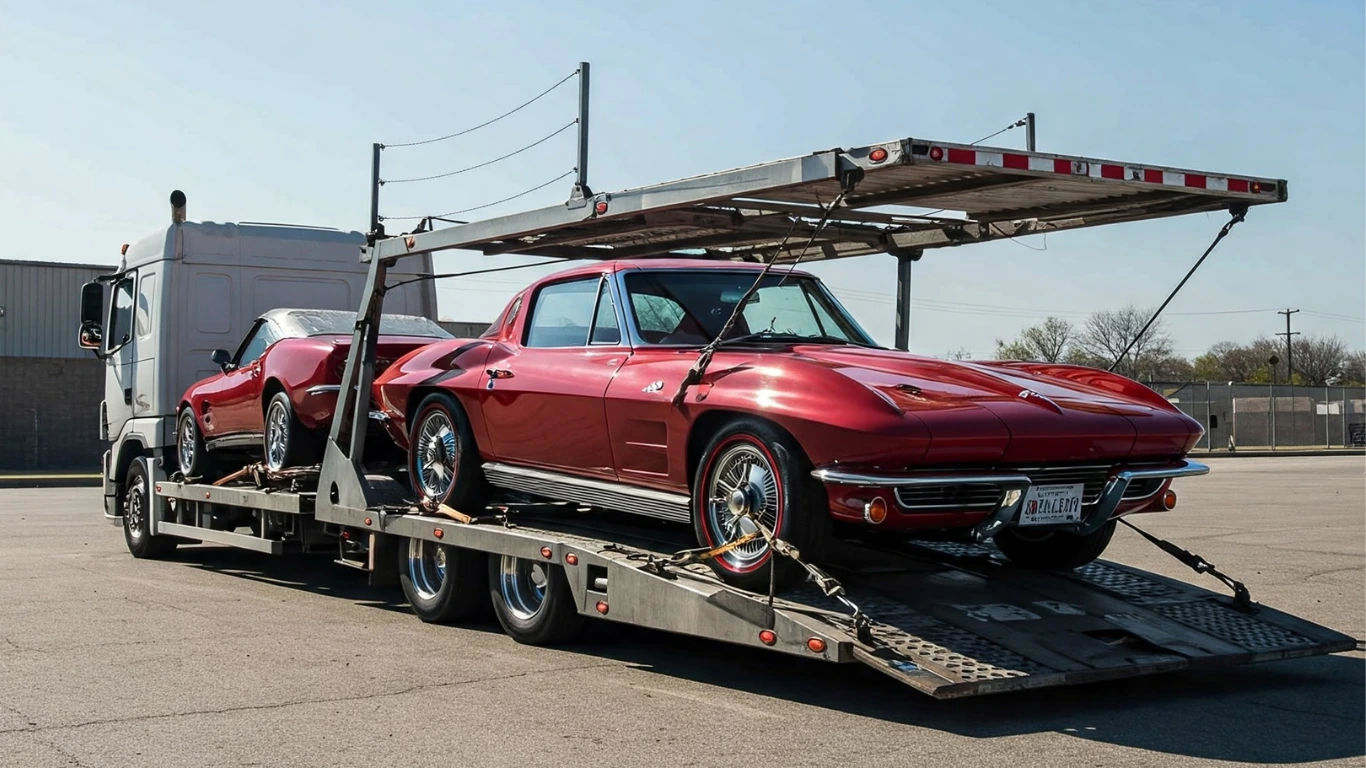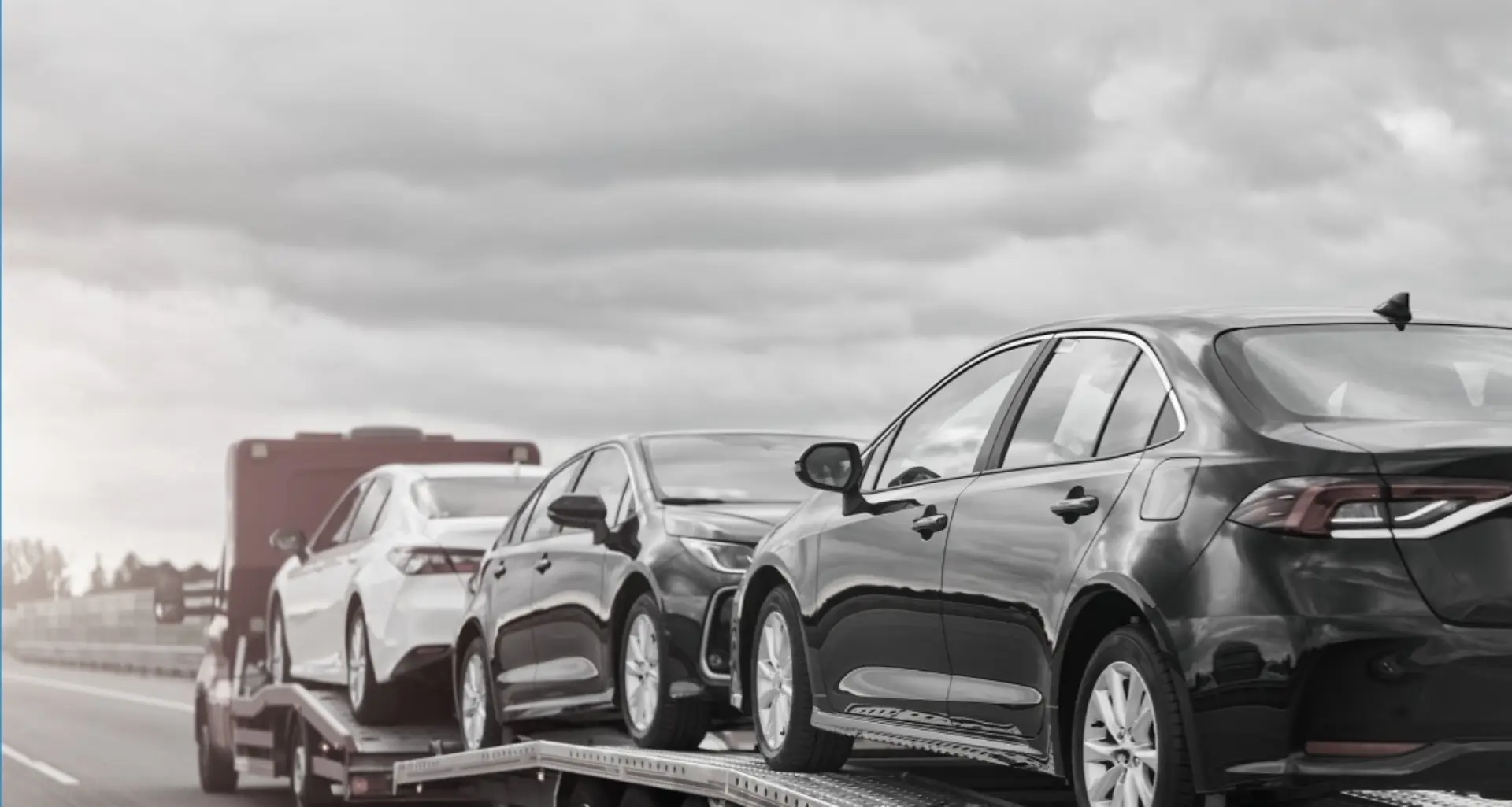
Classic Car Shipping Service
Being the owner of a classic car is always accompanied by numerous considerations, and moving it from one location to another is one of them. Classic vehicle shipping is not the same as a normal everyday car, it's all about protecting its value, delicate components, and historical significance. At Rapid Auto Shipping, our classic car shipping service backed by fourteen years of experience, ensures your cherished vehicles reach their destination safely, efficiently, and on time.
Why Rapid Auto Shipping is the Best Choice for Classic Car Shipping
At Rapid Auto Shipping, we know that your vintage or classic car is a sentimental possession rather than just a car. Whether your classic car is being sold, bought, or relocated, our classic car shipping experts guarantee hassle-free, safe, and secure transportation. Here's why entrusting your beloved car to our reliable hands is the best solution:

Superior Protection for Your Classic Car:
Because of their value and delicate parts, classic and vintage vehicles demand more care. Our included transportation choice guarantees your car comes in perfect condition by providing maximum protection from weather, road trash, and possible damage.
Expert Handling by Trained Professionals:
Our staff specializes in high-value, antique car transport solutions. Using industry-best loading techniques and securing methods to stop any movement during transit, our qualified drivers treat classic cars with the greatest care.
Fully Insured for Your Peace of Mind:
Your vehicle's safety comes first. Comprehensive insurance coverage is part of our classic auto shipping program, so you can relax knowing your vintage car is safe all through the trip.
Hassle-Free and Convenient Transport:
Long distance driving in a classic car can cause unnecessary wear and tear. Your car is safely delivered with our expert classic vehicle transport service, saving you extra mileage, mechanical problems, and travel costs.
Flexible Transport Options to Fit Your Needs:
Based on your budget and the level of protection required, we provide both open and enclosed transportation choices. While open transport is a budget-friendly option for classic car owners searching for reasonably priced classic vehicle shipping, enclosed classic car transport offers the best degree of security.
As one of the best collector car transport companies, our goal is to provide first-rate auto shipping solutions specifically for vintage and classic cars. Our knowledge, modern safety precautions, and dedication to customer happiness ensure a flawless and worry-free delivery.
Flexible Classic Car Hauler Options for Safe and Effective Shipping
We believe every classic car is different and calls for specific care during transportation. Thus, we provide a number of choices for classic car hauling catering to your particular requirements. Whether you are moving a valuable antique or a vintage collectible, we have the correct solution.
Enclosed Classic Car Transport: Maximum Protection
Our enclosed classic car transport service is the best option for the maximum degree of safety. Your vintage car is covered from weather, road trash, and outside elements within a totally enclosed trailer. This is the recommended choice for highly valuable vintage cars that call for extra attention.
Open Auto Transport: Cost-Effective & Reliable
Open auto transportation is a fantastic choice if you're trying for a less expensive solution. Like dealers or collectors moving multiple cars, your car will be firmly fastened onto an open trailer. Although this choice exposes the vehicle to environmental elements, it is still a safe and often used shipping choice.
Door to Door Classic Vehicle Transport: Hassle-Free Pickup & Delivery
Max convenience comes from our door to door classic vehicle transport. To reduce handling and guarantee a seamless experience, we pick up your vintage car from your doorsteps and directly deliver it to your given location.
Expedited Classic Car Shipping: Fast & Efficient
Require your classic car shipped right away. As classic car shippers, our expedited classic car shipping service guarantees the fastest delivery by giving your vehicle top priority for shipping. For auctions, auto shows, or last-minute moves, this option is perfect.
Cost to Ship a Classic Car: Pricing Breakdown & Key Factors
Vintage car transport requires special care, and several factors can affect the cost to ship a classic car. Whether you are moving a luxury antique, a rare collectible, or a vintage muscle car, knowing the pricing structure will enable you to make an informed decision.
Average Cost Estimates:
Under 100 miles, short distances
Perfect for local moves and short-distance transport
Long distances over 1,000+ miles
Economical rates for cross-country shipping
Important Factors Influencing Cost to Ship a Classic Car
Pricing Example
Shipping a classic Mustang from Chicago to Los Angeles (approximately 2,000 miles) might cost anywhere between $1,500 to $2,500, depending on the transportation method and particular shipping conditions.
Process of Classic Car Shipping Service
Our classic car shipping process is easy and hassle-free. To book your classic auto shipping, follow simple steps:
Request an Instant Auto Shipping Quote:
Getting an auto transport quote is the first step to ship a classic car. Fill out the details in the auto shipping calculator, or get in touch with us by email or call (833) 233-4447.
Booking of the Shipment:
Once you get the auto transportation quote, you need to schedule your shipments. For your convenience, we provide electronic contracts. An email with a link will be sent to you so you can conveniently schedule your service online.
Pickup:
On the appointed day and within the scheduled time limit, our skilled auto transport driver will come to pick up your classic vehicle. Before loading the car on the carrier, they will inspect it and record its condition.
Transportation:
The carrier will provide you with an estimated arrival time a few hours before delivery. If you are unable to do so, you can ask a reliable person to accept the car on your behalf.
Essential Tipsfor Hassle-Free Classic Car Shipping
We know your classic car is more than just a car; it's a reflection of your passion, dedication and hard work. If you're shipping your beloved car across the country for relocation, shipping a car to a relative, or buying your dream vehicle from out of state, we're here to make shipping easy and secure.
As we give our all to protect your vehicle, you also have the responsibility to prepare our vehicle appropriately. Preparing your car ahead of time allows us to go the extra mile and make sure everything goes smoothly. Here are a few tips for you to prepare your car for the journey:
Give Your Car a Good Clean
A clean car isn't just for appearances; it makes it easier for us to photograph the condition of your vehicle before it's transported. Take a few minutes to wash the outside and clean out any debris in the interior. This way, you and our drivers can quickly spot and record any existing scratches or damages.
Snap Photos for Your Peace of Mind
We know how much your vehicle is worth to you, and we do everything we can to safeguard it. Before pickup, take a few photos of your car from different angles, including close-ups of any existing damage. These photos likely serve as a handy reference when your vehicle arrives.
Remove Personal Items
As much as we'd like to help move your favorite beach chair or gym bag, removing all personal items from your car is best. This keeps your stuff safe and makes sure your car ships as securely as possible. And it keeps the weight down to safe levels.
Check Under the Hood
We take care of the road; you take care of the engine. Keep your vehicle in good working order by checking for leaks, topping off fluids, and charging its battery. Let us know if there are any quirky features so our drivers can handle your vehicle with precaution.
Adjust Tire Pressure and Fuel Level
Tires full of air make loading and unloading a breeze. Leave a quarter tank of fuel, just enough for a seamless transition at pickup and delivery without adding extra weight.
Prepare Key Documents and the Keys
Please keep your registration and any other required shipping documents available. Also, remember to bring an extra set of keys for us!
At Rapid Auto Shipping, we handle your vehicle like it's our own. By taking these simple steps, you'll help us give your vehicle the best care possible on the road. Got questions or special requests? Don't be afraid to call us; we're always here to help.
Other Vehicles We Specialize in Transporting
We provide dependable shipping options not only for classic cars but also for a broad range of vehicles. Our knowledgeable staff guarantees safe and secure transportation whether you need us to move a luxury car, a motorbike, or even an oversized vehicle.
Luxury, Exotic & Antique Car Transport:
High-end cars require more security and care. Our enclosed transportation choices guarantee a damage-free delivery and best protection for exotic, sports, and luxury cars.
Motorcycle Transport:
we also have expertise in motorcycle shipping service; we provide both open and enclosed delivery to protect your bike from road debris and environmental elements.
SUVs, Trucks & Oversized Vehicles:
Larger vehicles including vans, pickup trucks, and SUVs call for specific transportation options. Our staff guarantees safe loading and delivery even for lifted or modified vehicles.
RV & Motorhome Transport:
Needs to move RV or motorhome? From small camper vans to big motorhomes, our professional transportation services handle everything.
Heavy Equipment & Specialty Vehicles:
Offering both domestic and long-distance shipping options, we move building tools, farming gear, and other large vehicles.
Boat & Watercraft Transport:
Whether you need to ship a jet ski, fishing boat, or yacht, we offer specialist carriers and expert handling to guarantee seamless arrival to your location.

0 Yr
In the business
0K
Quotes
0K
Vehicles Shipped
0.0/5
Overall Rating
About Rapid Auto Shipping
At Rapid Auto Shipping, we know that putting your car in someone else's hands is a big decision. That's why we're committed to delivering a hassle-free, worry-free, and secure auto transport experience. With years of experience and thousands of happy customers in the U.S., we've established a reputation for excellence.
Our team is aware that shipping a car, especially a vintage or valuable one, requires careful handling and attention to detail. For this reason, we provide customised transportation solutions with open transport for affordable choices and enclosed shipping for maximum security. To guarantee a flawless shipping experience, we give customer satisfaction top priority along with regular updates, open pricing, and dedicated customer support.
Rapid Auto Shipping is dedicated to making relocation, vehicle purchase from out of state, or classic car shipping services seamless, safe, and stress-free. Get the quote now!

Everything you need to know about our auto transport services
Enclosed auto shipping will protect your classic car from any road hazards and be safeguarded from potentially harmful weather conditions.
Classic automobile shipping is similar to conventional vehicle shipping. Get exotic car shipping quotes, book a transport, update your insurance, and examine the car before and after transfer. The enclosed auto transport is the best way to move a classic car.
Your personal items are not covered by insurance, and for safety reasons, we generally do not allow it inside the vehicle. If you need to ship items, consider using a separate shipping service. However, small, non-valuable items up to 100 pounds are allowed at your peril, so it's best to discuss your specific needs with our shipping coordinator.
Yes! We transport non-running vehicles with a winch-equipped trailer. There is an upcharge for the additional gear and labor. When making reservations online or with our representative on our phone reservation lines, please mark your vehicle as a breakdown or not running.
Booking the service should be made two weeks before to accommodate the requested pick-up dates and ensure that there are enough carriers. Summer, holiday season, and others usually call for a booking to be made at least three or four weeks before the service date. Last-minute shipments are also accepted and incur an expedited charge, but they could get pretty expensive. Early booking may ensure a reasonable price rate and avoid confusion when planning to arrange things.
Yes, a person must be present to accept the vehicle at both pick-up and delivery. The inspection report must be signed, and they must also supply a spare set of keys. Have a friend or relative sign on your behalf if you are unavailable.